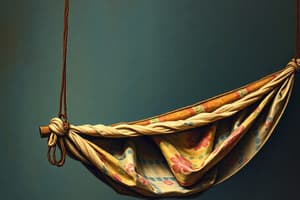Podcast
Questions and Answers
Which of the following materials is NOT commonly used in the manufacture of textile slings?
Which of the following materials is NOT commonly used in the manufacture of textile slings?
- Polypropylene
- Acrylic (correct)
- Polyamide (nylon)
- Polyester
Which type of textile sling is known for its ability to distribute the load across its entire width, reducing the risk of point contact damage?
Which type of textile sling is known for its ability to distribute the load across its entire width, reducing the risk of point contact damage?
- Chain sling
- Wire rope sling
- Flat woven webbing sling (correct)
- Roundsling
Which of the following materials is considered a natural fiber often used in the production of rope slings?
Which of the following materials is considered a natural fiber often used in the production of rope slings?
- Polyamide (nylon)
- Manila (correct)
- HMPE (High Modulus Polyethylene)
- Polyester
What is the primary function of the protective cover in a roundsling?
What is the primary function of the protective cover in a roundsling?
What is the main advantage of using flat woven webbing slings over wire rope or chain slings?
What is the main advantage of using flat woven webbing slings over wire rope or chain slings?
Which of the following factors is NOT typically considered when comparing different types of textile slings?
Which of the following factors is NOT typically considered when comparing different types of textile slings?
Which type of textile sling is most commonly used for general lifting purposes?
Which type of textile sling is most commonly used for general lifting purposes?
What is a characteristic feature of a rigging screw?
What is a characteristic feature of a rigging screw?
What is the primary load-bearing component of a roundsling?
What is the primary load-bearing component of a roundsling?
Which of the following terminal fittings can be connected to a turnbuckle?
Which of the following terminal fittings can be connected to a turnbuckle?
What is the purpose of the drilled inspection hole in a rigging screw?
What is the purpose of the drilled inspection hole in a rigging screw?
What distinguishes a turnbuckle from a rigging screw?
What distinguishes a turnbuckle from a rigging screw?
Which statement about rigging screws is true?
Which statement about rigging screws is true?
What is the primary use of a bolt with a hexagon head, hexagon nut, and split cotter pin?
What is the primary use of a bolt with a hexagon head, hexagon nut, and split cotter pin?
What is the primary advantage of using an eyebolt with a link compared to a collared eyebolt?
What is the primary advantage of using an eyebolt with a link compared to a collared eyebolt?
What is the maximum allowable angle of the load to the axis of the screw thread for an eyebolt with a link?
What is the maximum allowable angle of the load to the axis of the screw thread for an eyebolt with a link?
What is the typical size range for the thread of an eyebolt with a link?
What is the typical size range for the thread of an eyebolt with a link?
What is the primary design feature of a collared eyebolt that distinguishes it from an eyebolt with a link?
What is the primary design feature of a collared eyebolt that distinguishes it from an eyebolt with a link?
What is a key characteristic of an eyebolt with a link that makes it suitable for a wide range of loading applications?
What is a key characteristic of an eyebolt with a link that makes it suitable for a wide range of loading applications?
What is the primary function of the collar on a collared eyebolt?
What is the primary function of the collar on a collared eyebolt?
Which of the following combinations of components is typically used where a positive and permanent connection is required?
Which of the following combinations of components is typically used where a positive and permanent connection is required?
Which of the following is NOT a common use of shackles in lifting operations?
Which of the following is NOT a common use of shackles in lifting operations?
What are the three main types of shackles used for lifting today?
What are the three main types of shackles used for lifting today?
What is the primary factor determining a shackle's safe working load (SWL)?
What is the primary factor determining a shackle's safe working load (SWL)?
How do older, now withdrawn shackle standards differ from current standards?
How do older, now withdrawn shackle standards differ from current standards?
What is the key difference between a large dee shackle and a small dee shackle?
What is the key difference between a large dee shackle and a small dee shackle?
Which type of shackle would be suitable for attaching a wire rope thimble to a lifting hook?
Which type of shackle would be suitable for attaching a wire rope thimble to a lifting hook?
Which of the following statements about shackles is TRUE?
Which of the following statements about shackles is TRUE?
Which of the following statements is TRUE regarding shackle sizing?
Which of the following statements is TRUE regarding shackle sizing?
What is a key advantage of man-made fibre roundslings compared to wire rope and chain slings?
What is a key advantage of man-made fibre roundslings compared to wire rope and chain slings?
Which type of sling has declined in use in favor of newer textile slings?
Which type of sling has declined in use in favor of newer textile slings?
What is a disadvantage of fibre rope slings compared to other textile slings?
What is a disadvantage of fibre rope slings compared to other textile slings?
How are the eyes of fibre rope slings formed?
How are the eyes of fibre rope slings formed?
What is a recommended protective measure when using multi-leg fibre rope slings?
What is a recommended protective measure when using multi-leg fibre rope slings?
Why is it difficult to identify different types of fibre rope visually?
Why is it difficult to identify different types of fibre rope visually?
What does the process of splicing a fibre rope sling achieve?
What does the process of splicing a fibre rope sling achieve?
What is one of the key differences between fibre rope slings and chain or wire rope slings?
What is one of the key differences between fibre rope slings and chain or wire rope slings?
What is the primary limitation of the Dynamo Eyebolt compared to other eyebolts?
What is the primary limitation of the Dynamo Eyebolt compared to other eyebolts?
What must not exceed 5° when using yokes with eyebolts in pairs of the same capacity?
What must not exceed 5° when using yokes with eyebolts in pairs of the same capacity?
Why is a reduction in the maximum load necessary when eyebolts are subjected to angular loads?
Why is a reduction in the maximum load necessary when eyebolts are subjected to angular loads?
What is the maximum thickness of shims that can be used to align eyebolts?
What is the maximum thickness of shims that can be used to align eyebolts?
In terms of thread sizes, what is the range for metric coarse pitch series eyebolts?
In terms of thread sizes, what is the range for metric coarse pitch series eyebolts?
Which statement about collar eyebolts is true?
Which statement about collar eyebolts is true?
What is the SWL capacity range for imperial threaded dynamo eyebolts?
What is the SWL capacity range for imperial threaded dynamo eyebolts?
What are the capacities of collar eyebolts for SWL?
What are the capacities of collar eyebolts for SWL?
Flashcards
Textile Slings
Textile Slings
Lifting devices made from man-made or natural fibres for load handling.
Man-Made Fibres
Man-Made Fibres
Synthetic materials like nylon, polyester, and polypropylene used for slings.
Natural Fibres
Natural Fibres
Natural materials such as manila, sisal, and hemp used for slings, less common now.
HMPE Slings
HMPE Slings
Signup and view all the flashcards
Flat Woven Webbing Slings
Flat Woven Webbing Slings
Signup and view all the flashcards
Roundsling
Roundsling
Signup and view all the flashcards
Load bearing core
Load bearing core
Signup and view all the flashcards
Protective Cover
Protective Cover
Signup and view all the flashcards
Fibre Rope Slings
Fibre Rope Slings
Signup and view all the flashcards
Man-Made Fibre Roundslings
Man-Made Fibre Roundslings
Signup and view all the flashcards
Handling Characteristics
Handling Characteristics
Signup and view all the flashcards
Splicing Techniques
Splicing Techniques
Signup and view all the flashcards
Multi-Leg Slings
Multi-Leg Slings
Signup and view all the flashcards
Thimbles in Rope Slings
Thimbles in Rope Slings
Signup and view all the flashcards
Load Application
Load Application
Signup and view all the flashcards
Identification Challenges
Identification Challenges
Signup and view all the flashcards
Shackles
Shackles
Signup and view all the flashcards
Types of Shackles
Types of Shackles
Signup and view all the flashcards
Dee Shackle
Dee Shackle
Signup and view all the flashcards
Large Dee Shackle
Large Dee Shackle
Signup and view all the flashcards
Small Dee Shackle
Small Dee Shackle
Signup and view all the flashcards
Shackle Material Grades
Shackle Material Grades
Signup and view all the flashcards
WLL in Shackles
WLL in Shackles
Signup and view all the flashcards
Old vs New Shackle Standards
Old vs New Shackle Standards
Signup and view all the flashcards
Rigging Screw
Rigging Screw
Signup and view all the flashcards
Turnbuckle
Turnbuckle
Signup and view all the flashcards
Terminal Fittings
Terminal Fittings
Signup and view all the flashcards
Inspection Hole
Inspection Hole
Signup and view all the flashcards
Right and Left-Hand Threads
Right and Left-Hand Threads
Signup and view all the flashcards
Hexagon Head Bolt
Hexagon Head Bolt
Signup and view all the flashcards
Split Cotter Pin
Split Cotter Pin
Signup and view all the flashcards
Eyebolt Types
Eyebolt Types
Signup and view all the flashcards
Eyebolt with Link
Eyebolt with Link
Signup and view all the flashcards
SWL Rating
SWL Rating
Signup and view all the flashcards
Collared Eyebolt
Collared Eyebolt
Signup and view all the flashcards
Load at an Angle
Load at an Angle
Signup and view all the flashcards
Articulation in Eyebolts
Articulation in Eyebolts
Signup and view all the flashcards
SWL (Safe Working Load)
SWL (Safe Working Load)
Signup and view all the flashcards
Dynamo Eyebolt
Dynamo Eyebolt
Signup and view all the flashcards
Thread Sizes
Thread Sizes
Signup and view all the flashcards
Angular Loading
Angular Loading
Signup and view all the flashcards
Alignment in Eyebolts
Alignment in Eyebolts
Signup and view all the flashcards
Metric vs. Imperial Eyebolts
Metric vs. Imperial Eyebolts
Signup and view all the flashcards
Shims for Alignment
Shims for Alignment
Signup and view all the flashcards
Study Notes
Textile Slings
- Textile slings can be made from man-made fibers (nylon, polyester, polypropylene) or natural fibers (Manila, sisal, hemp)
- Specialist man-made fibers like HMPE (High Modulus Polyethylene) are used for specialized lifting slings
- These fibers exhibit different reactions to temperature, chemicals, and the environment
- Textile slings exist in various forms: flat woven webbing, round slings, and fiber rope slings
Types of Textile Slings
- Flat Woven Webbing Slings: These are also known as belt slings, are used for versatile lifting, and are ideal for loads needing support. They spread the load, preventing point stress and potential damage to the loaded surface. Although more pliable than rope or chain slings, they are less robust and more susceptible to damage
- Round Slings: These consist of a core (load-bearing) wrapped in a protective outer sleeve. They are soft, pliable, and easy to handle, suitable for delicate surfaces, yet less robust than other types like wire rope.
- Fiber Rope Slings: These are traditional textile slings, although newer textile types are more common today. They're less pliable and bulkier than other textile slings. They require careful handling as they can cause point contact versus distributed load.
Shackles
- Shackles are common lifting accessories used in various ways, to connect loads, slings, and appliances.
- Three main types: bow, dee, and grab
- Made from steel, with higher-quality alloys providing a higher working load limit.
- Older standards fully specify all shackle dimensions, while newer standards primarily detail key dimensions, with others given as maximum or minimum values.
- Based on diameter of material or Working Load Limit (WLL).
Pins
- Shackle pins can be screwed or bolt, nut and cotter pin types (safety pins)
- Screwed pins are versatile, but movement and vibration can cause loosening.
- Bolt, nut and split cotter pins provide a more secure connection, useful for applications requiring a permanent connection.
Eyebolts
- Eyebolts are widely used items in lifting, but misuse can lead to accidents.
- Three common types: eyebolt with link, collared, and dynamo
- Eyebolts with a link distribute load better, especially at an angle.
- Collared eyebolts are suitable for both axial and angular loading.
- Dynamo eyebolts are most basic, suitable only for direct vertical (axial) loads.
Rigging Screws and Turnbuckles
- Rigging screws and turnbuckles are used for adjusting tension in lifting systems, whether in combination with other elements or by themselves.
- Turnbuckles have a threaded body with terminal fittings (hook, forks, etc.)
Studying That Suits You
Use AI to generate personalized quizzes and flashcards to suit your learning preferences.





